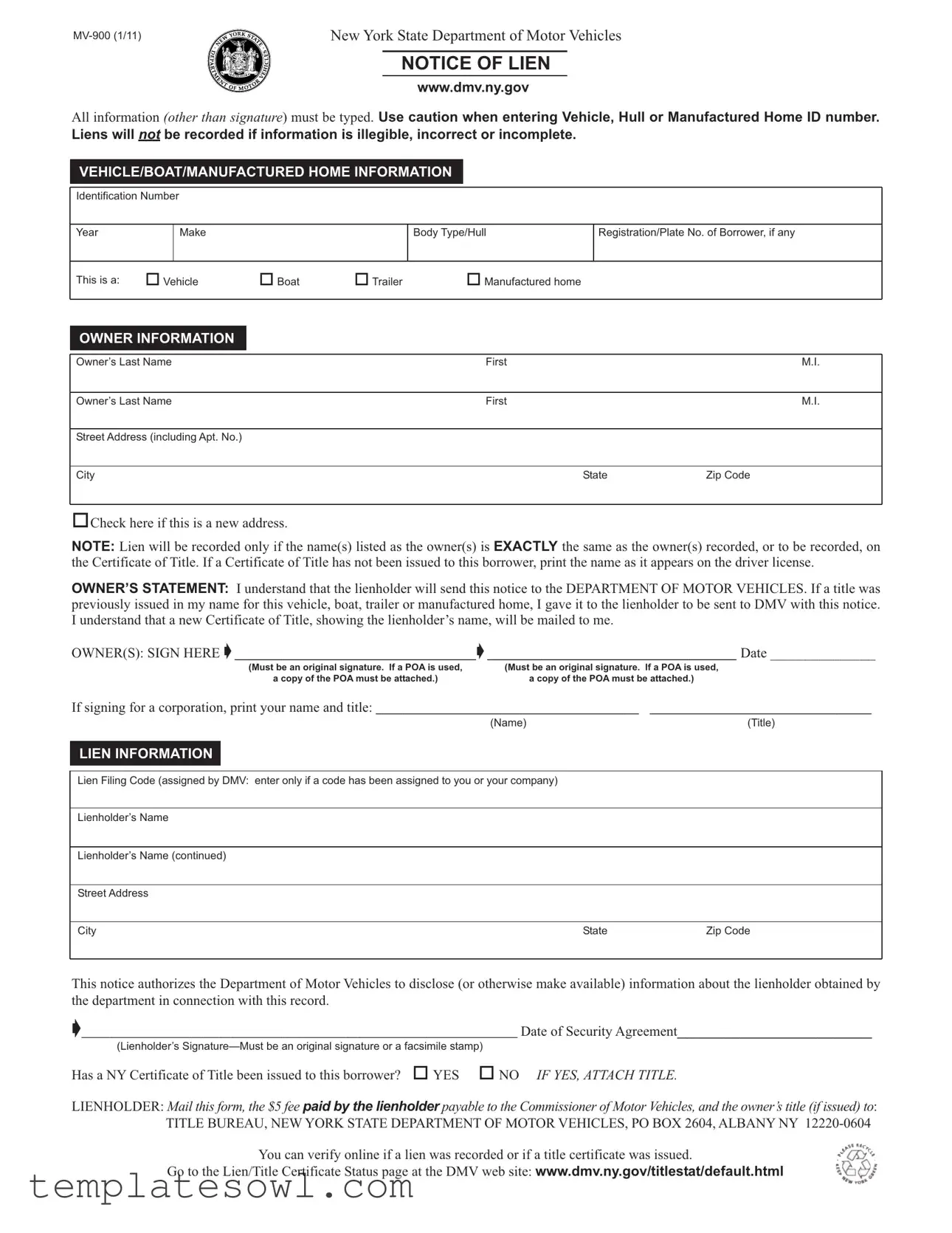NewYorkStateDepartmentofMotorVehicles
NOTICE OF LIEN
www.dmv.ny.gov
All information (other than signature) must be typed. Use caution when entering Vehicle, Hull or Manufactured Home ID number.
Liens will notbe recorded if information is illegible, incorrect or incomplete.
VEHICLE/BOAT/MANUFACTURED HOME INFORMATION
Identification Number
Registration/Plate No. of Borrower, if any
This is a: Vehicle |
Boat |
Trailer |
Manufactured home |
|
|
|
|
|
|
|
|
|
|
|
OWNER INFORMATION |
|
|
|
|
|
|
|
|
|
Owner’s Last Name |
|
|
First |
M.I. |
|
|
|
|
|
Owner’s Last Name |
|
|
First |
M.I. |
|
|
|
|
|
StreetAddress (includingApt. No.) |
|
|
|
|
|
|
|
|
|
City |
|
|
State |
Zip Code |
|
|
|
|
|
Checkhereifthisisanewaddress.
NOTE: Lien will be recorded only if the name(s) listed as the owner(s) is EXACTLY the same as the owner(s) recorded, or to be recorded, on theCertificateofTitle.IfaCertificateofTitlehasnotbeenissuedtothisborrower,printthenameasitappearsonthedriverlicense.
OWNER’S STATEMENT: IunderstandthatthelienholderwillsendthisnoticetotheDEPARTMENTOFMOTORVEHICLES.Ifatitlewas previously issued in my name for this vehicle, boat, trailer or manufactured home, I gave it to the lienholder to be sent to DMVwith this notice. IunderstandthatanewCertificateofTitle,showingthelienholder’sname,willbemailedtome.
OWNER(S):SIGNHERE➧_______________________________➧________________________________ Date_______________
(Must be an original signature. If a POAis used, |
(Must be an original signature. If a POAis used, |
a copy of the POAmust be attached.) |
a copy of the POAmust be attached.) |
Ifsigningforacorporation,printyournameandtitle:______________________________________ |
________________________________ |
|
(Name) |
|
(Title) |
|
|
|
LIEN INFORMATION |
|
|
|
|
|
|
|
Lien Filing Code (assigned by DMV: enter only if a code has been assigned to you or your company) |
|
|
|
|
|
|
Lienholder’s Name |
|
|
|
|
|
|
Lienholder’s Name (continued) |
|
|
|
|
|
|
StreetAddress |
|
|
|
|
|
|
City |
State |
Zip Code |
|
|
|
|
This notice authorizes the Department of MotorVehicles to disclose (or otherwise make available) information about the lienholder obtained by thedepartmentinconnectionwiththisrecord.
➧________________________________________________________________________ DateofSecurityAgreement_________________________
(Lienholder’s Signature—Must be an original signature or a facsimile stamp)
HasaNYCertificateofTitlebeenissuedtothisborrower? YES NO IFYES,ATTACHTITLE.
LIENHOLDER:Mailthisform,the$5feepaidbythelienholderpayabletotheCommissionerofMotorVehicles,andtheowner’stitle(ifissued)to:
TITLEBUREAU,NEWYORKSTATEDEPARTMENTOFMOTORVEHICLES,POBOX2604,ALBANYNY 12220-0604
Youcanverifyonlineifalienwasrecordedorifatitlecertificatewasissued.
GototheLien/TitleCertificateStatuspageattheDMVwebsite:www.dmv.ny.gov/titlestat/default.html

